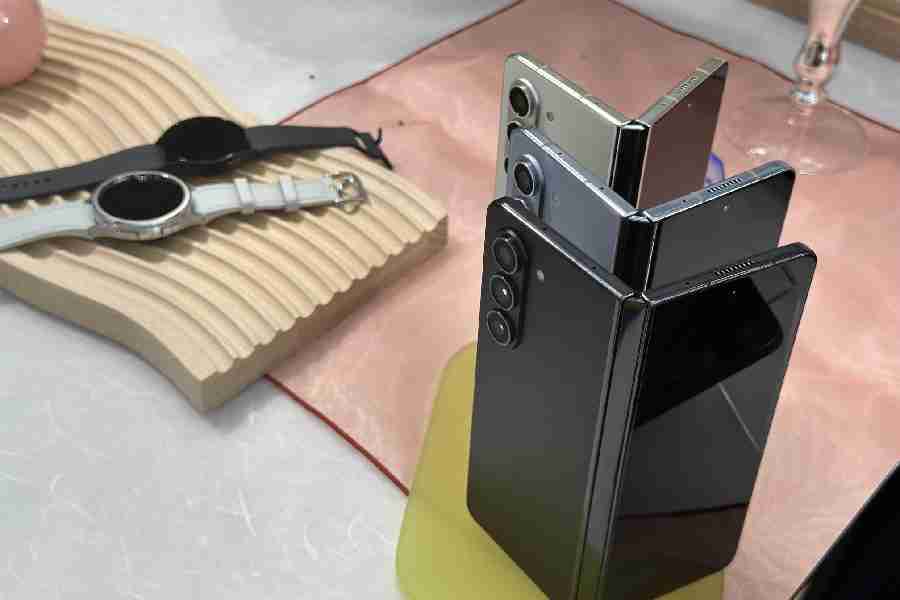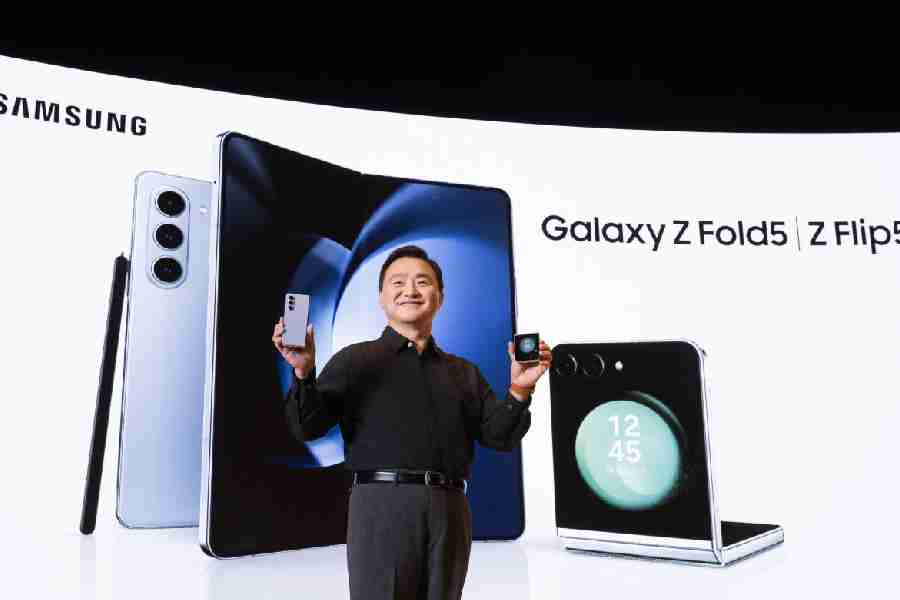It’s early morning in Seoul and Samsung’s flagship store in Gangnam has just opened for business. Within minutes young men and women fill the store, checking out accessories and whatever is on display. Most of their queries are around the new Galaxy Z Flip5 and Galaxy Z Fold5, the new foldable devices from Samsung. They are also curious about the new Galaxy Tab S9 and the Galaxy Watch6 series.
Multiple market research companies expect the accumulated global sales of foldable smartphones to exceed 100 million devices within the next five years. That’s a considerable figure and Samsung is in the driver’s seat because it has the first-mover advantage.

Samsung Galaxy Z Fold5 is expected to help the South Korean tech giant achieve a higher market share in the premium category The Telegraph
A few hours later, we had an appointment with the man in the thick of activities — TM Roh, president and head of MX Business, Samsung Electronics. It had only been a few hours since the company unveiled its latest flagship devices. K-pop sensation Suga was in the audience and he looked happy with the evening’s proceedings. If Suga is happy, it’s reason enough for young people to give the new devices a dekko.
“India is one of the fastest growing and the largest markets in the world, and it is also a very important strategic market that is leading the way for popularisation of the foldables and also a market that is highly sensitive to technological innovation and also very much open to innovation. Galaxy products already account for 35 per cent MS (market share) in the super-premium ($1,000-plus) segment in India, and with the newly-launched Z Flip5 and Z Fold5 we are now aiming at over 50 per cent market share,” he tells us when we meet.
“The foldable category itself in 2023... it is expected to top 30 million units of cumulative sales all over the world in 2023. So, it means that it’s going to be an important tipping point this year where the foldable category is going to become a mainstream category. And I do believe that the foldable category is going to expand to other categories like the tablet and PC and continue to develop,” says Roh.
Samsung launched the first foldable in 2019 and since then the category has only been improving. The company has been delivering devices with better performance, better features, and better usability. “Users want it to be lighter and thinner, longer lasting. They also want to use more features, the features that they want more powerfully anytime, anywhere. So we have been listening to the voices of the customers, and it is the voices of the customers that we intend to keep reflecting in our next product. Another voice from the customers is for better performance of the camera, especially for the foldable. So they want to have the kind of camera performance that is on par with the features and the performance of more premium products like Galaxy S series. So that is also what we have done for the first time, for the Flip5 and Fold5 this time. And, we will continue to incorporate better and stronger camera features as well,” says Roh.
The outlook on AI

Samsung Galaxy Z Flip5 has a fashion quotient that will engage youngsters
Now that the form factors in the foldable category have been established, a lot of future progress will also depend on how software gets deployed. We ask Roh about the importance of AI and software development as far as foldable phones go.
“For the mobile industry, mobile devices and particularly, Galaxy devices, it has been inseparable with AI. I mean, it has been and it is now. And we are applying AI technology to optimise features, upgrade the feature, and also to enable personalisation. Also, in particular, on-device AI is providing very important support for camera features and camera performance. Not only that, but also to optimise gaming, provide suggestions, and also the Finder, AI is playing a very important role on the Galaxy device as well,” says Roh.
The buzz around generative AI is new but tech giants like Samsung and Apple have been quietly offering meaningful AI for many years now. “Obviously generative AI is getting a lot of attention these days. But to use generative AI, consumers also need an entry point, and we believe that for the entry point, mobile devices or laptops could be the best. Another important factor in AI is to better understand the consumer’s need as well as the usage patterns in order to best apply and put to use AI, including generative AI.”
As always, Samsung believes in working with partners to develop new technologies. “In order to keep developing this technology of AI, including generative AI, Samsung Mobile is already investing a lot of resources to develop solutions, either in-house or also in collaboration with leading AI companies like Google and Microsoft. We have strategic cooperation with these leading AI companies at Google and Microsoft to also come up with collaborative solutions. We are developing it in two paths — internal solutions and collaborator. And, in fact, for the AI, especially in developing the internal solutions, the Samsung R&D centre in India is playing a very important role,” says Roh.
Going big on wearables
Samsung now has an ecosystem of products that work seamlessly together. You begin an activity on your Fold5 and then move it to, say, the Tab S9 Ultra or even get things done on the Watch6. Smartwatches have gone far beyond just step counting but few companies can offer accurate readings and health parameters that can help the user. This year, the focus is on sleep-related parameters.
“For mobile devices, including wearables, the biggest characteristic is that they are either held with you or worn by you anytime, anywhere. So utilising the devices that are on you all the time, in other words, utilising this characteristic or strength of being on a person all the time, we can also collect health-related data through such devices and such data can be sent to the smartphones or other mobile devices, either on device or on the cloud, and that would then be analysed for better purposes or based on such information, better guidance or advice can be provided to the users,” says Roh.
He rightly points out that the human desire is to be healthy at all times. “I believe that the mobile devices, especially Samsung Galaxy, are in a very good position to provide support, for that desire and to provide the necessary services and guidance for that. And that is precisely the reason why the mobile industry is investing heavily in digital health. And also, as you have heard from our presentation yesterday (at the launch), that is also the reason why Samsung Mobile is also investing and working on health to provide better products and better features.”
Making it easy to buy devices
One question many keep asking is who is buying these expensive phones and how? It’s simple: Samsung has come up with several payment schemes to make it easy for everyone to buy a device. Samsung Finance+ is one of the company’s most successful programmes. It’s enabling an office-goer to pick up something like a Fold5 and once they start using it, the benefits of the device are obvious.
“What we hear from the foldable users is that once you start using it, then you can immediately feel all its advantages, like a large screen, the fact that it folds into a more compact shape, and also the various features that you can use on the large screen,” says Roh. “How we are going to get the Indian consumers to experience the phone first, either by going to the retail stores or from users that they know. So, from the existing users, maybe they can get more information and get to experience the phone as well. So, we hope that many more of them can actually get their hands on and experience the foldable phones.”
Ultimately it comes down to purchasing the phone. “We want to make it easier for consumers everywhere, including Indian consumers, to access them and to purchase them. So, we are also providing sales programmes together with Samsung India and our sales partners. One example is the programme that we have in India — Samsung Finance+. This is one such programme to make it more accessible to Indian consumers. We’ll continue to work on that front as well, not only by ourselves but along with our partners,” says the youngest president ever appointed at Samsung.
If things go to plan, 2023 could be the tipping point for foldables as it becomes more accessible in terms of features as well as pricing.
“Cumulatively speaking, I would say that the foldable is already entering the stage of becoming mainstream. For example, what we can see is the third-party applications, they’re trying to optimise their experience on foldable and strengthen the offers and experience on foldable. So, I think that that is one good example that the foldable is gaining more and more traction in the global market. Once we reach that threshold of 100 million units per year, and again, cumulatively speaking, by that time, the foldable would’ve become a major player in the premium segment.”
When it comes to innovation, there are largely two pathways that Samsung is looking at. “One such path is to keep improving the performance and the quality of the foldable itself. So, we would maintain such strength while at the same time providing longer usage time in terms of battery and also providing better performance, especially camera features. We will also continue to innovate on the form factor itself. So that is one path of Samsung’s innovation. For any new form factor or improved form factor, it will be introduced to the market when we believe that it is ready to provide meaningful innovation and experience to the consumers.
“Another path of innovation for us is to further popularise the foldable, making it as affordable as possible. So that is also one approach that we are working very hard on. To that end, we are also working very hard with the strategic parts suppliers. We are working hard to continue with the development and also develop the leading technology,” says Roh, who joined Samsung Electronics in 1997.
There’s optimism in the industry that the worldwide sales of foldable phones are growing at a faster pace. You may say that the form factor is not entirely new in 2023 but that’s how long it takes for new technology to make inroads — a few years of hard work.
“The Indian market is sensitive to innovation. It’s also very open and receptive to innovation. Another trend that we are seeing coming out of the Indian market is a very rapidly rising demand for high-end premium products. Aside from the Indian market, also some Southeast Asian markets and also some European markets, we see that the demand for premium high-end products continues to grow in these other markets as well.”










